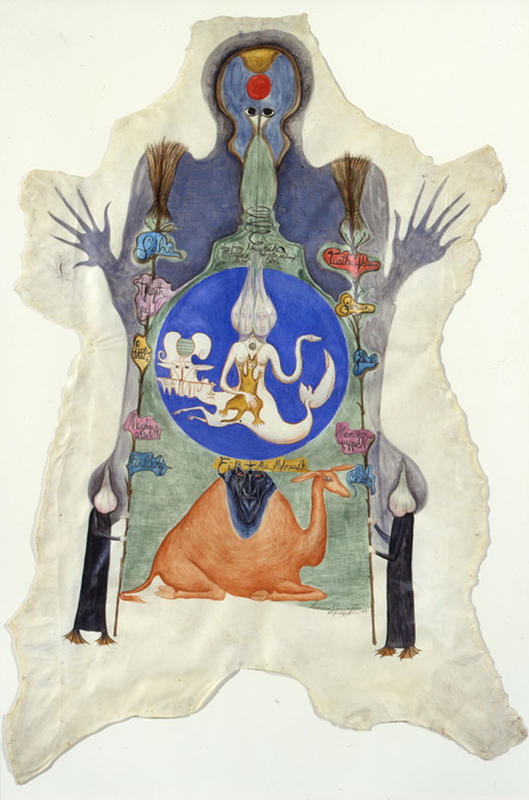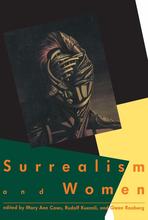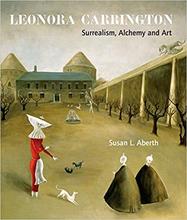More about Samhain Skin
- All
- Info
- Shop

Sr. Contributor
When you think about it, the animal skin that Samhain Skin is painted on really isn’t that shocking.
And artists know how to shock their viewers. Bodily fluids, skin, and the like usually do the trick; just ask Piero Manzoni. But humans have written on animal skins pretty much since we figured out how to write, and vellum has been a popular medium for the written word since the Middle Ages. So if that’s true, then why does this artwork still totally give me the heebie jeebies? Maybe it’s because the vellum that Carringon used in this work is still in the shape of a lamb.
Creepy or not, this work is referencing Carrington's family’s cultural connection to Ireland and Gaelic history. Sidhe (pronounced “shee”), are a race of Celtic fairies that Carrington’s grandmother claimed were her family’s ancestors. According to Celtic lore, the Sidhe were angels cast down from heaven that now wreak havoc during Samhain (pronounced “sow-win”), a Celtic Pagain harvest festival. During Samhain, the physical and spiritual worlds break down, allowing humans and otherworldly beings to interact with one another. Ancient Celts left offerings for the Sidhe and dressed as animals and monsters so the fairies didn’t kidnap them. Medieval Celts carved turnips, and then later pumpkins, to make jack-o-lanterns. Sound familiar? Centuries later, nineteenth-century Irish immigrants brought Halloween to the United States, and the idea of Halloween pranks can even be traced to the mischief that Celts believed the Sidh caused during Samhain.
If you still can’t put your finger on what’s so creepy here, try focusing on the garlic-headed creatures tending to the main figure. Now, I love garlic as much as the next girl, but Carrington and Remedios Varo, her Surrealist partner-in-crime, really loved garlic. After Nazis separated Carrington from her lover Max Ernst during World War II, Pablo Picasso hooked her up with his friend Renato Leduc, a Mexican ambassador, who helped her escape Europe. In Mexico, Carrington met Varo and the two quickly became besties. Together, they explored alchemy, the occult, and the arts. The garlic creatures refer to the ingredients of their magical endeavors.
Carrington and Varo explored the idea of the feminine through a distinctly Surrealist lens, layering their personal histories, like Carrington’s Celtic roots, into works that also represent their time together in Mexico. We can wonder, but we’ll never really know what these mysterious works mean. Carrington wanted to spark curiosity and force us to ponder all the wonderful weirdness in her work, so there are no easy answers.
Sources
- History.com. “Samhain.” 21 August 2018. https://www.history.com/topics/holidays/samhain Accessed 28 October 2019.
- Library Ireland. “Popular Notions concerning the Sidhe race.” https://www.libraryireland.com/AncientLegendsSuperstitions/Popular-Noti…. Accessed 28 October 2019.
- Moorhead, Joanna. “My ‘wild child’ cousin, the Surrealist painter Leonora Carrington.” 25 March 2017. Family. The Guardian. https://www.theguardian.com/lifeandstyle/2017/mar/25/my-wild-child-cous…. Accessed 28 Oc
- National Museum of Women in the Arts. “Samhain Skin.” Our Collection. Explore. https://nmwa.org/works/samhain-skin. Accessed 28 October 2019.
- Rennicks, Rich. “The History of Vellum and Parchment.” 12 July 2017. The Antiquarian Booksellers’ Association of America. https://www.abaa.org/blog/post/the-history-of-vellum-and-parchment. Accessed 28 October 2019.
- Schlatter, N. Elizabeth/ “From the Collection: Leonora Carrington’s Samhain Skin.” National Museum of Women in the Arts. Women in the Arts. Summer 2006., https://static.squarespace.com/static/5314d904e4b01148f95148aa/5315bd48…
- Suter, Hadley. “The Surrealist, Feminist Magic of Leonora Carrington.” 28 May 2019. Cultured. https://www.culturedmag.com/leonora-carrington/. Accessed 28 October 2019.













